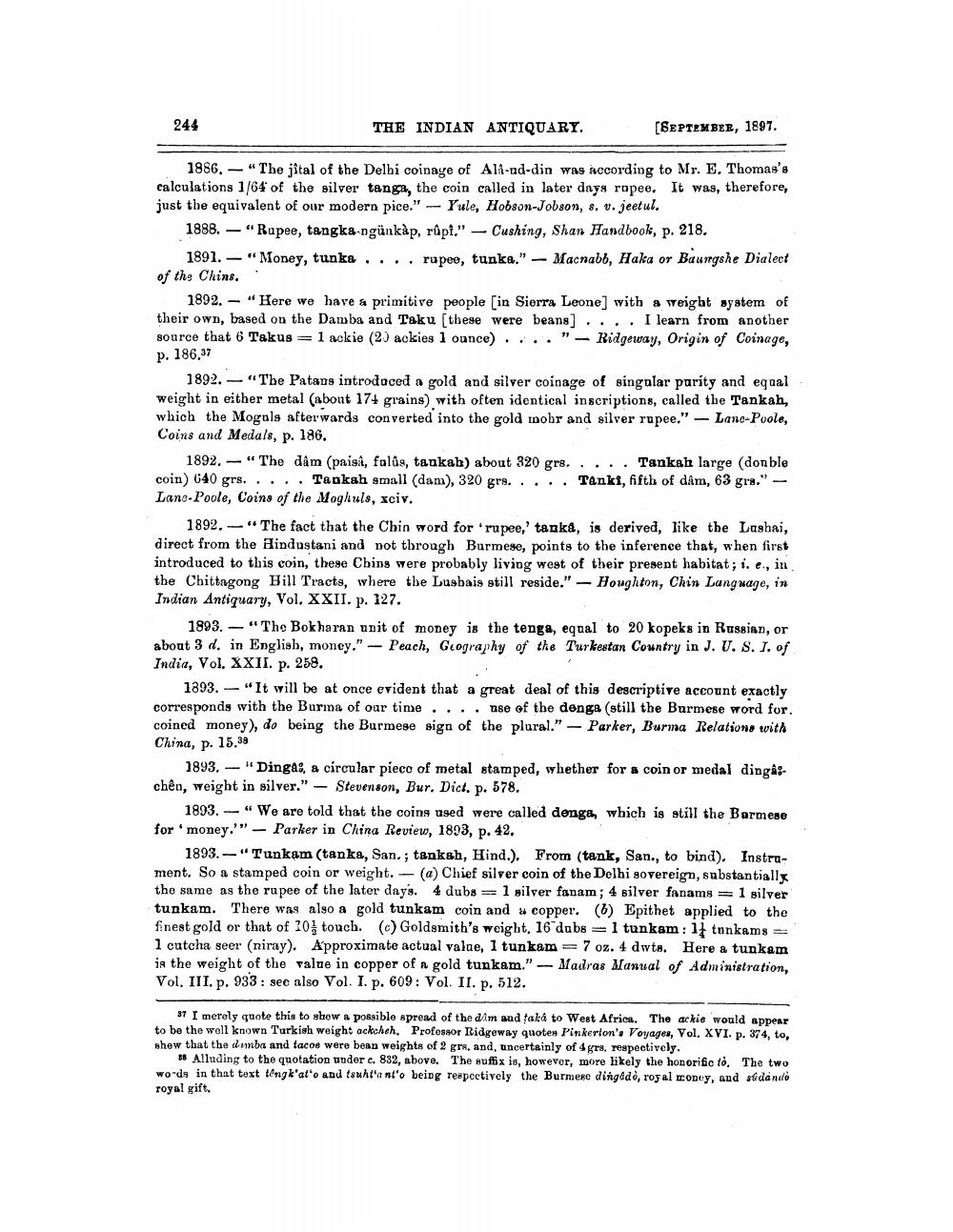________________
THE INDIAN ANTIQUARY.
1886. "The jital of the Delhi coinage of Ali-ud-din was according to Mr. E. Thomas's calculations 1/64 of the silver tanga, the coin called in later days rapee. It was, therefore, just the equivalent of our modern pice." - Yule, Hobson-Jobson, s. v. jeetul.
1888.
"Rupee, tangka-ngünkap, rûpt." - Cushing, Shan Handbook, p. 218.
"Money, tunka. . . . rupee, tunka." - Macnabb, Haka or Baurgshe Dialect
244
1891. of the Chins.
1892. "Here we have a primitive people [in Sierra Leone] with a weight system of their own, based on the Damba and Taku [these were beans] . . . . I learn from another source that 6 Takus = 1 ackie (2) ackies 1 ounce)... -Ridgeway, Origin of Coinage, p. 186.37
[SEPTEMBER, 1897.
1892. "The Patans introduced a gold and silver coinage of singular purity and equal weight in either metal (about 174 grains) with often identical inscriptions, called the Tankah, which the Moguls afterwards converted into the gold mohr and silver rupee." - Lane-Poole, Coins and Medals, p. 186.
1892. "The dâm (paisà, falás, tankah) about 320 grs. coin) 640 grs. . . . . Tankah small (dam), 320 grs.... Lane-Poole, Coins of the Moghuls, xciv.
... Tankah large (donble Tanki, fifth of dâm, 63 gra." -
1892. The fact that the Chin word for 'rupee,' tanka, is derived, like the Lushai, direct from the Hindustani and not through Burmese, points to the inference that, when first introduced to this coin, these Chins were probably living west of their present habitat; i. e., in. the Chittagong Hill Tracts, where the Lushais still reside." Houghton, Chin Language, in Indian Antiquary, Vol. XXII. p. 127.
1893.
"The Bokharan unit of money is the tenga, equal to 20 kopeks in Russian, or about 3 d. in English, money." Peach, Geography of the Turkestan Country in J. U. S. I. of India, Vol. XXII. p. 258.
-
1893. "It will be at once evident that a great deal of this descriptive account exactly corresponds with the Burma of our time. . . . use of the denga (still the Burmese word for. coined money), do being the Burmese sign of the plural." Parker, Burma Relations with China, p. 15.39
1893. "Dingas, a circular piece of metal stamped, whether for a coin or medal dinga:chên, weight in silver." Stevenson, Bur. Dict. p. 578.
1893."We are told that the coins used were called denga, which is still the Burmese for money.'" Parker in China Review, 1893, p. 42.
1893.Tunkam (tanka, San. ; tankah, Hind.). From (tank, San., to bind). Instrument. So a stamped coin or weight. (a) Chief silver coin of the Delhi sovereign, substantially the same as the rupee of the later days. 4 dubs 1 silver fanam; 4 silver fanams = 1 silver tunkam. There was also a gold tunkam coin and a copper. (6) Epithet applied to the finest gold or that of 10 touch. (c) Goldsmith's weight, 16 dubs 1 tunkam: 1 tankams 1 cutcha seer (niray). Approximate actual value, 1 tunkam = 7 oz. 4 dwts. Here a tunkam is the weight of the value in copper of a gold tunkam." Madras Manual of Administration, Vol. III. p. 933: see also Vol. I. p. 609: Vol. II. p. 512.
37 I merely quote this to show a possible spread of the dim and taká to West Africa. The ackie would appear to be the well known Turkish weight ackcheh, Professor Ridgeway quotes Pinkerton's Voyages, Vol. XVI. p. 374, to, shew that the dumba and tacos were bean weights of 2 grs, and, uncertainly of 4 grs, respectively.
58 Alluding to the quotation under c. 832, above. The suffix is, however, more likely the honorific to. The two words in that text tengk'at'o and tsuht'a nt'o being respectively the Burmese dingido, royal money, and súdándo royal gift.




